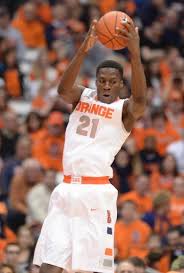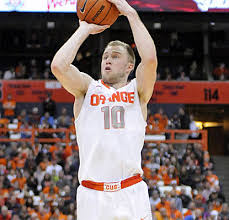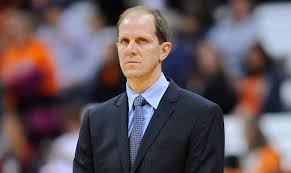Syracuse assistant head coach
Mike Hopkins is in the middle of his head coaching assignment. He has guided the Orange to a 3-2 record during the first five games of head coach
Jim Boeheim's 9 game suspension.
Hopkins has been put into a very difficult situation, one that I think he has handled well so far. The are four obstacles that he faces, and two of them really are no resolvable; he just needs to do the best he can.
First, Hopkins was given very little notice regarding the transition to being head coach. Hopkins and Jim Boeheim were preparing for a January transition; instead the NCAA sprung the news on the two of them about 48 hours before the Georgetown game. At that point, Hopkins and Boeheim were working off a plan to have 30 days to prepare for the situation, and with the busy week in the Bahamas for the Battle for Atlantis, along with the Wisconsin and Georgetown games, I am sure it was something the two of them were planning to really look into once the holiday season got closer.
Second, Jim Boeheim is allowed to have no contact with anyone associated with the Syracuse basketball program. Unfortunately that means that Hopkins does not have access to his mentor for guidance. He does not get to talk to the man who has guided his basketball life as a player and a coach for the past 25+ years. He doesn't get the opportunity to share the happy moments nor commiserate over the problems with the man who has been there for his basketball career.
Third, Hopkins has to run another coaches system. Fortunately for Hopkins, he is extremely familiar with Boeheim's system. He is very familiar with what Boeheim would want to be done, what work needs to be done with each player, and what Boeheim's hopes were for the players as the season progressed. Those are pluses for Hopkins. But, he must try to adhere to that system as much as he can because after nine games, Hopkins has to turn the team back over to Boeheim. Hopkins cannot introduce new theories to the team, or try to change how the team operates. He must stay the course that Jim Boeheim had set for the team.
The fourth obstacle may be the biggest. Hopkins has to be the head coach for 9 games and a month of time. He must behave as the head coach. BUT, after the suspension is done, he must return to being the assistant head coach. The relationship of the head coach to the players is different than the relationship of the assistant coaches to the players. The head coach runs the show, his instructions are absolute, and the players must toe the line that has been set.
The assistant coach helps the head coach carry out his plan. But the assistant is also a buffer between the head coach and the players. Assistants get to buddy up with the players, they are the avenue for the players to vent their frustrations. They are the individuals who work with the players one-on-one every day. It is a different relationship.
Hopkins cannot jump fully into the head coach mode, as he has to return to that assistant coach mode. He cannot change his relationship with the players on a short term basis; that would lead to dysfunction later in the season. He cannot really define himself as the head coach.
I think Hopkins has done well with the hand he has been dealt. This team is an inconsistent squad. The Georgetown game was destined to be a problem because of how the NCAA rolled out the suspension. The St. John's game was an embarrassment; however, we all knew there was the chance this team could lay an egg on any given game day. That game really has been the only game under Hopkins watch that was played poorly and ended poorly.
The one thing we do know is different is how Hopkins handles the press conferences. That was inevitable. Boeheim is a one-of-a-kind in the press conferences, with curmudgeon style, wry and dry humor, sarcasms, and cynicism with the media. Hopkins is significantly lighter in his tone, and appears more open. Of course, he doesn't have 40 years of baggage with him either.
Good luck to Hopkins. It will be interesting to see what his true coaching style is in a few years.






